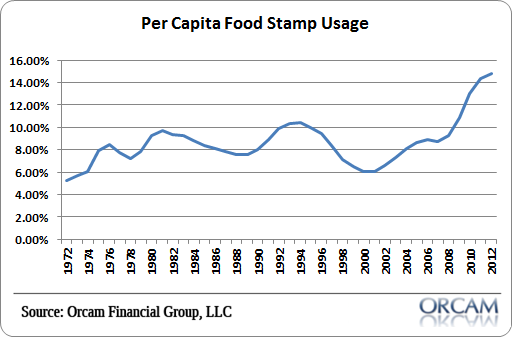I’ve seen a common theme in the comments section from the “America is falling into an abyss” crowd – the recent rise in food stamp usage. Without getting political, I figured I’d take a look at the raw data and see what we could conclude. Here goes nothing.
First of all, food stamp usage ALWAYS rises in a recession so the recent surge is not remotely surprising. As you can see in Figure 1 below, every recession since the 1970’s (when this data is first available) has seen a sharp increase in food stamp usage. I used a year over year rate of change in order to compare the current environment on an apples to apples basis with past events. It’s too easy to look at the “record high” or the headline figure in food stamps and simply conclude that things are worse than they’ve ever been. The reality is that food stamps rose at about a 20% year over year rate at the worst point in the current recession and has since declined to a 4.25% year over year pace. So, the rate of change is still positive, but it’s come way down from its worst levels.
I’ve also provided the per capita food stamp usage in figure 2. Obviously, the picture looks far more bleak than the figure 1 image. Per capita food stamp usage is at its all-time high. But the rate of change is clearly slowing so it does help to keep things in perspective there.
It’s interesting to note a few things from this data and the program itself:
- I was surprised to discover that 55% of all participants are children (under 18) or elderly (over 65).
- Food stamp usage has been on the rise since 2001 with the exception of a meager year over year decline in 2007.
- The recent recession was comparable to both surges in the 70’s, but was much larger than more recent recessions.
- The annual rate of change has averaged 8% since inception.
- The 2012 rate of change (4.25%) was substantially lower than the average rate of change.
- BUT, the rate of change is still positive which means that food stamp usage is still on the rise even if there is a modest recovery occurring.
(Figure 1)
(Figure 2)
Mr. Roche is the Founder and Chief Investment Officer of Discipline Funds.Discipline Funds is a low fee financial advisory firm with a focus on helping people be more disciplined with their finances.
He is also the author of Pragmatic Capitalism: What Every Investor Needs to Understand About Money and Finance, Understanding the Modern Monetary System and Understanding Modern Portfolio Construction.



Comments are closed.